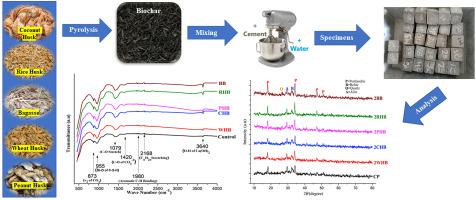Journal of Building Engineering ( IF 6.7 ) Pub Date : 2022-06-23 , DOI: 10.1016/j.jobe.2022.104850 Muhammad Haris Javed , Muhammad Ali Sikandar , Waqas Ahmad , Muhammad Tariq Bashir , Raid Alrowais , Muhammad Bilal Wadud

|
Using waste materials to replace a fraction of cement in concrete is economical and ecologically beneficial. In this work, cement pastes and mortars were fabricated with five different kinds of unsaturated biochars such as bagasse biochar (BB), coconut husk biochar (CHB), peanut husk biochar (PHB), rice husk biochar (RHB), and wheat husk biochar (WHB) at a dosage rate of 1-5 wt% relative to cement. The CO2 adsorption capacity of biochars was estimated to be in the range of 1.25–1.72 mmol/g. The influence of biochar addition on the setting time, water demand for normal consistency, compressive strength, water absorption, and apparent porosity of cement pastes and mortar was assessed. The analytical characterizations such as X-Ray diffraction (XRD), Fourier Transform infrared (FTIR), Scanning electron microscopy (SEM), and Raman spectroscopy analyses were employed for the analysis of biochar-based cement pastes. The results reveal that increasing the biochar dosage in cement pastes reduces setting time and increases the water demand irrespective of biochar type. The best results for water absorption, apparent porosity, and compressive strength were obtained at a dosage of 2 wt% relative to cement for each biochar. The analytical characterizations of biochar-based cement pastes showed the greater formation of hydration products leading to the development of a dense structure. The analytical results corroborated the mechanical performances. The efficacy of biochars in controlling the properties of cement pastes and mortars decreased in the order BB > RHB > PHB > CHB > WHB.
中文翻译:

各种生物炭对水泥浆体和砂浆的物理、力学和微观结构特性的影响
使用废料代替混凝土中的一小部分水泥是经济和生态有益的。在这项工作中,水泥浆和砂浆是用五种不同的不饱和生物炭制备的,如甘蔗渣生物炭(BB)、椰子壳生物炭(CHB)、花生壳生物炭(PHB)、稻壳生物炭(RHB)和小麦壳生物炭。 (WHB) 相对于水泥的 1-5 wt% 的剂量率。CO 2生物炭的吸附能力估计在 1.25-1.72 mmol/g 的范围内。评估了添加生物炭对水泥浆和砂浆的凝结时间、正常稠度的需水量、抗压强度、吸水率和表观孔隙率的影响。采用 X 射线衍射 (XRD)、傅里叶变换红外 (FTIR)、扫描电子显微镜 (SEM) 和拉曼光谱分析等分析表征方法对生物炭基水泥浆体进行分析。结果表明,增加水泥浆料中的生物炭用量会减少凝结时间并增加需水量,而与生物炭类型无关。对于每种生物炭,在相对于水泥 2 wt% 的剂量下获得了吸水率、表观孔隙率和抗压强度的最佳结果。生物炭基水泥浆体的分析表征表明水化产物的形成更多,导致致密结构的发展。分析结果证实了机械性能。生物炭对水泥浆体和砂浆性能的控制效果按 BB > RHB > PHB > CHB > WHB 的顺序递减。











































 京公网安备 11010802027423号
京公网安备 11010802027423号